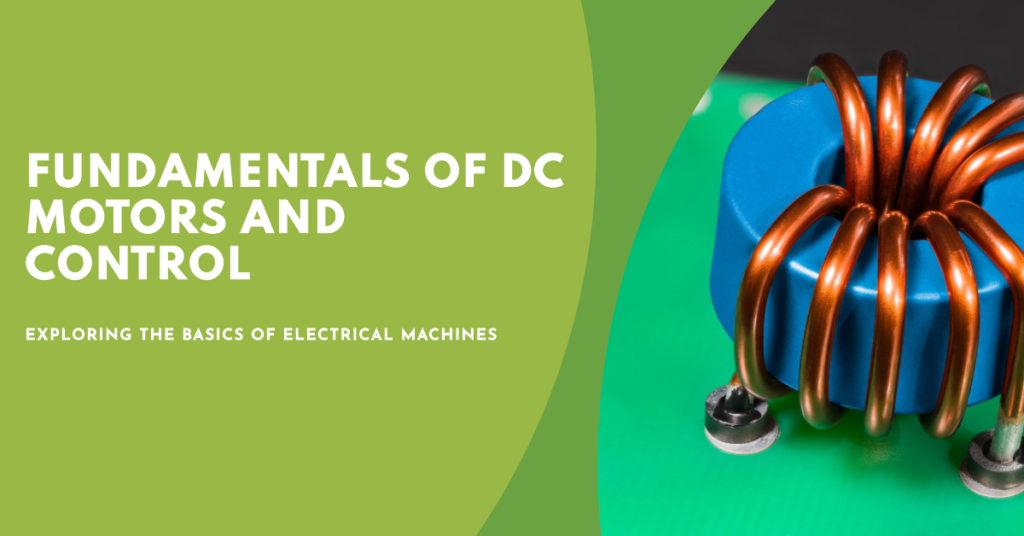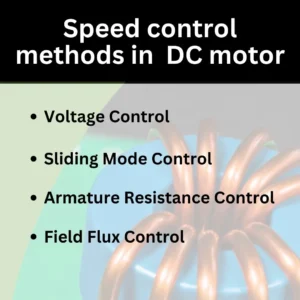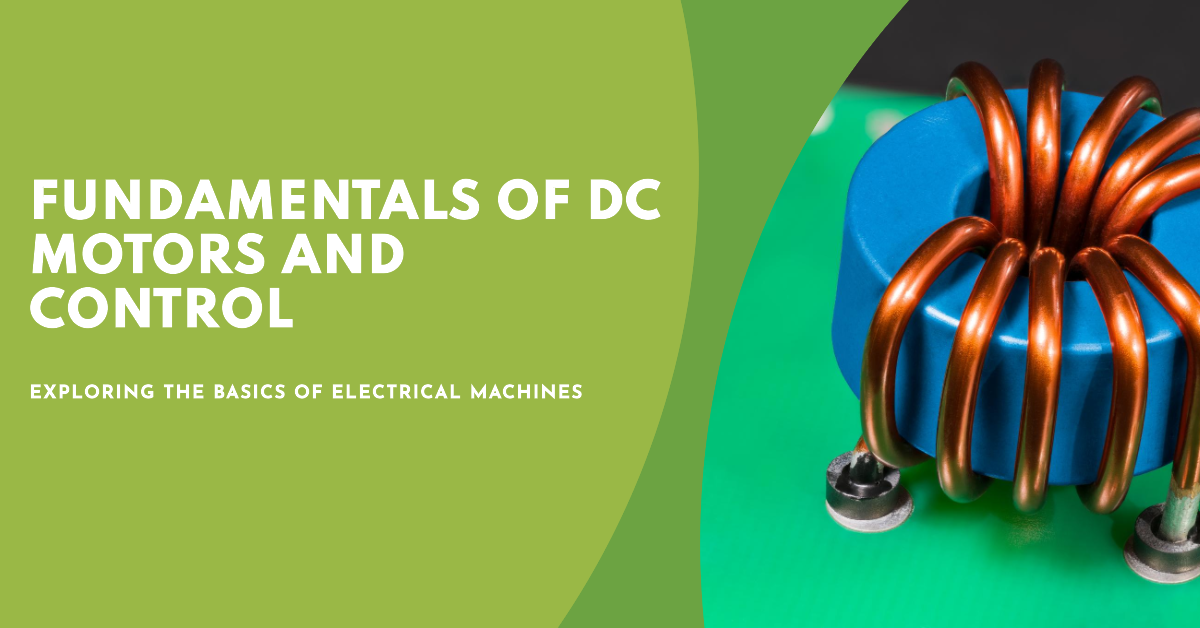Table of Contents
If you want to learn about electrical machines, you must have a solid understanding of dc motors, drives, and control. The need for electrical machines in industrial applications is very important. As electrical machines play a vital role in producing products fast.
By understanding of the fundamentals of electrical machines, engineers can easily analyze, design and debug electrical systems. Engineers can also enhance system effectiveness and performance which can boosts production and lowers costs for industrial applications.

Introduction to Electrical Machines
Definition of Electrical Machines
Electrical machines are devices that can change electrical energy to mechanical energy and vice versa. Various sectors including manufacturing, renewable energy, automotive, and power generation use electrical machines for their production. Electric machines are important for the creation of electric and hybrid vehicles.
Importance and Applications
Electrical machines play a crucial role in a wide range of industries and applications. They are essential for transportation, including electric cars, trains, and ships, as well as renewable energy generation, such as wind turbines and solar panels. In addition, electrical machines are utilized in passenger aircrafts for various functions, including propulsion and auxiliary power generation. Furthermore, they are also critical in naval applications, including submarines and aircraft carriers.
DC Motors: Basics and Principles
Understanding Direct Current (DC)
Direct current refers to the flow of electric charge in one direction.This type of current is typically produced by batteries or DC power supplies. Direct current is a crucial component in various industries and applications. Direct current is essential for powering electronic devices, such as smartphones, laptops, and televisions. It is also widely used in transportation systems, such as electric vehicles and trains. Additionally, direct current is utilized in renewable energy systems, such as solar panels and wind turbines, to convert and store energy.
How DC Motors Work
Electrical machines DC motors are widely used in various industries for their ability to convert electrical energy into mechanical energy.
The working principle of a DC motor involves the interaction between a current-carrying conductor and a magnetic field. When a current-carrying conductor, such as a wire, is placed in a magnetic field, a force is exerted on the conductor that causes it to move. This movement is what converts the electrical energy into mechanical energy, allowing the motor to perform useful work. The DC motor operates based on the Lorentz law, which states that a current-carrying conductor placed in a magnetic field will experience a force that is perpendicular to both the direction of the current and the magnetic field.
Types of DC Motors
There are several types of DC motors that are widely used in various industries and applications. Some of the common types of DC motors include permanent magnet DC motors, series DC motors, shunt DC motors, and compound DC motors. Each type of DC motor has its own unique characteristics and advantages, making them suitable for specific applications. Permanent magnet DC motors are popular due to their compact size, high efficiency, and strong torque output.
Components of DC Motors
Armature
The armature is the rotating part of a DC motor and is composed of coils or windings that carry the current.
Commutator
The commutator is a split ring that reverses the direction of the current in the armature windings, ensuring a continuous rotational motion.
Brushes
Brushes are conductive elements that maintain electrical contact with the commutator and supply current to the armature.
Field Winding
The field winding in a dc motor is responsible for creating the magnetic field that interacts with the armature to generate the motor’s rotational movement.
Fundamentals of DC Motor Drives
Purpose and Function of Drives
The purpose of DC motor drives is to control the speed and torque of a DC motor. By controlling the voltage or current supplied to the motor’s armature terminals, the speed and direction of rotation can be adjusted. Electrical machines DC motor drives are essential in various industrial applications, such as machine tools, paper mills, textile industry, electric traction, and robotics.
Types of DC Motor Drives
There are many different types of DC motor drives, including brushed direct current motors, brushless DC motors, and DC servo motors, each with their own advantages and applications. These various types of DC motor drives offer different levels of efficiency, control, and performance, allowing for a wide range of applications in industries such as automotive, robotics, aerospace, and more.
Advantages and Disadvantages
DC motor drives offer several advantages, such as simplicity, ease of application, reliability, and favorable cost. These drives have been widely used in industrial applications due to their high performance and high starting torque. However, there are also some disadvantages associated with DC motor drives.
One disadvantage is that electrical machines dc motors requires maintenance. DC motors require regular maintenance to ensure their continued performance and efficiency. Additionally, the cost of DC motors is higher compared to induction motors.
DC Motor Control Techniques
Open Loop Control
The open loop control technique for a DC motor is a simple and cost-effective method of controlling its speed and position. This method involves providing a constant input voltage to the motor’s armature terminals, which directly affects the motor’s speed. However, it is important to note that open loop control does not provide feedback on the actual motor speed. Instead, it relies solely on the input voltage to determine the speed.
Closed Loop Control
Closed-loop control is a technique used in the control of DC motors to achieve higher precision and accuracy in speed and position control. By using closed-loop control, the motor speed is continuously monitored and compared to a desired set point, allowing for adjustments to be made in real-time to maintain the desired speed and position despite changes in load or external factors. Closed-loop control involves the use of feedback from the motor to continuously adjust the driver circuit and keep the motor operating at the desired speed and position.
PWM Control
The PWM control technique for DC motors is a widely used method that allows for precise control of the motor’s speed and direction by adjusting the duty cycle of the PWM signal.
Importance of Speed Control in DC Motors
Applications Requiring Speed Control
Electrical machines DC motor drives are designed for various applications that require precise speed control. These applications include robotics, precision servos, industrial drives, and railway traction, among others. The flexibility in controller design of DC motors allows for accurate and efficient speed control in these applications. Furthermore, electrical machines DC motors are extensively used in machine tools, paper mills, and the textile industry, where the ability to adjust the speed is crucial for achieving optimal performance and production efficiency.
Methods of Speed Control
There are several methods of speed control in a DC motor. Some of the commonly used methods includes:

1.Voltage Control: The speed of a DC motor can be controlled by varying the voltage applied to its armature terminals. This can be achieved by changing the terminal voltage of the armature or by using techniques such as PWM to control the average voltage applied to the motor.
2.Armature Resistance Control: By changing the armature resistance, the speed of a DC motor can be controlled. This is done by adding external resistance to the armature circuit.
3.Field Flux Control: Another method of speed control in a DC motor is by controlling the field flux. This can be achieved by changing the field resistance or by using techniques such as field weakening or field weakening control.
4. Sliding Mode Control: Sliding mode control is a technique used to control the speed of a DC motor by continuously adjusting the control signal to drive the motor towards a desired speed.
Energy Efficiency and Performance Optimization
Factors Affecting Efficiency
There are several factors that can affect the efficiency of a DC motor. Some of these factors include the design and quality of the motor, the load on the motor, the speed at which the motor is operating, and the condition of the motor, such as the cleanliness of the brushes and the alignment of the commutator.
Techniques to Improve Efficiency
There are several techniques that can be employed to improve the efficiency of a DC motor. One such technique is the use of brushless DC motors, which have higher efficiency compared to traditional brushed DC motors. Another technique is the use of advanced motor control algorithms, such as field-oriented control, which can optimize the motor’s performance and reduce energy consumption.
Maintenance and Troubleshooting of DC Motors
Regular Maintenance Practices
Regular maintenance practices of DC motors play a crucial role in ensuring their optimal performance and longevity. A few key maintenance practices for electrical machines dc motors include regular inspection and cleaning of the motor and its components, lubricating moving parts, checking and replacing brushes as needed, monitoring and maintaining proper electrical connections, and conducting regular performance evaluations.
Common Issues and Solutions
Common issues with DC motors include overheating, motor failure, and poor efficiency. To overcome these issues, proper cooling mechanisms such as fan cooling or liquid cooling can be implemented to prevent overheating. Additionally, regular maintenance and inspection can help identify any potential issues and address them before they lead to motor failure.
Advancements in DC Motor Technology
Brushless DC Motors
Brushless DC motors are a type of electrical motor that offer several advantages over traditional brushed motors. These advantages include higher efficiency, longer lifespan, reduced maintenance requirements, and improved reliability. Additionally, brushless DC motors have a higher safety level due to the absence of brushes and commutators, which eliminates the risk of sparking and fire hazards.
High-Efficiency Motors
High-efficiency DC motors are designed to optimize energy consumption and reduce waste. These motors are engineered with advanced technologies and materials to achieve higher efficiency levels compared to traditional DC motors.
This increased efficiency translates into cost savings and a reduced carbon footprint, making high-efficiency DC motors a valuable choice for various applications, such as industrial machinery, robotics, and electric vehicles.
IoT Integration
IoT integration in DC motor technology has revolutionized the way we control and monitor motor performance, enabling enhanced efficiency, real-time data analysis, and remote operation capabilities. With the integration of IoT in DC motor technology, companies can now remotely monitor the performance of their motors, analyze real-time data, and make necessary adjustments to optimize efficiency and minimize downtime.
Future Prospects of DC Motors
Role in Sustainable Energy
DC motors play a crucial role in sustainable energy by offering significant reductions in energy consumption compared to conventional AC motors. The use of efficient DC motors can lead to up to a 40% reduction in energy consumption, which helps contribute to the overall goal of minimizing CO2 emissions and conserving energy resources. In addition, the economical advantage of employing high-efficiency DC motors further encourages their use in sustainable energy systems.
Emerging Applications
The emerging applications of electrical machines dc motors continue to expand, as they are being utilized in a variety of industries and sectors. These include but are not limited to:
- Mechanical systems: DC motors are widely used in mechanical systems for tasks such as conveyor belt operation, robotic arm movement, and precision positioning.
- Robots: DC motors are essential components in the field of robotics, as they provide the necessary torque and precise movement required for various robotic applications.
- Electric vehicles: DC motors play a crucial role in the propulsion systems of electric vehicles, where they convert electrical energy into mechanical energy to drive the wheels.
- Renewable energy: DC motors are employed in renewable energy systems, such as wind turbines and solar trackers, to convert the energy generated into usable electrical power.
Conclusion
Electrical machines, especially dc motors are very important devices in modern society. Understanding of electrical machines dc motors, drives and control are very crucial for optimizing power and efficiency. For the substantial development of our country dc motors plays very important role.
Power of Electrostatic Potential and Capacitance
Electric field charges and static electricity
Frequently Asked Questions
Q: What is the purpose of a commutator in a DC motor?
A: The commutator reverses the direction of current in the armature winding, enabling continuous rotation.
Q: What are the main types of DC motor drives?
A: The main types include chopper-controlled drives, four-quadrant drives, and pulse-width modulation (PWM) drives.
Q: How can DC motor efficiency be improved?
A: Efficiency can be improved through better design, and material selection.
